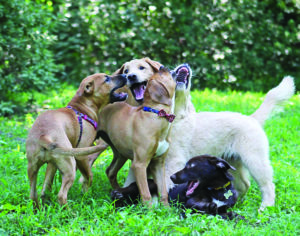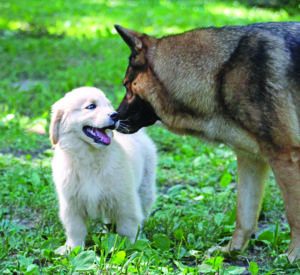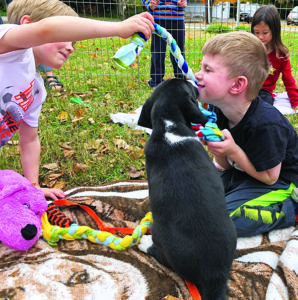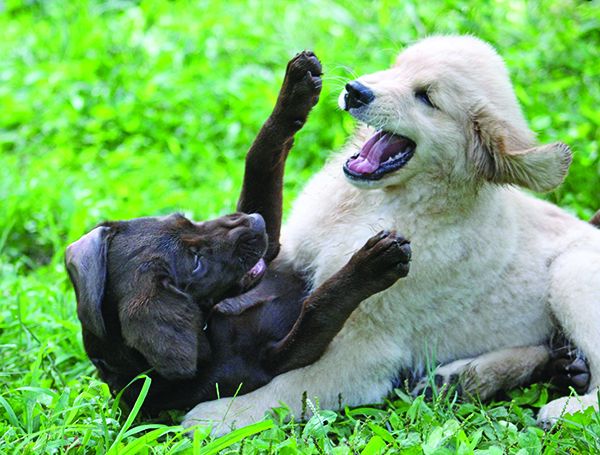Suddenly, thanks to COVID-19, the whole world is asking the question that’s all too familiar to savvy puppy owners: “How likely is this experience to result in infection, and is this particular interaction worth it?”
There’s a stretch in puppyhood – up through around 4 months – when puppies are typically vaccinated several times but cannot be considered fully immunized against parvovirus and distemper due to the potential for maternal antibody interference. (For in-depth information about serial puppy vaccinations, see “Puppy Vaccines,” WDJ October 2016.)
Lamentably, a convincing swath of research has identified that exact same stretch of time as the almost magic (but fleeting!) period when pups are wide open to new experiences that will set them up for a lifetime of confidence.
The tension between those two scientific truths presents owners with a dilemma after bringing home an 8-week-old pup. Staying at home those first two months is the only way to keep a pup 100% safe from infectious disease – but doing that could well lead to debilitating behavioral issues down the road.
So what’s an owner to do?
EDUCATED CHOICES ALLOW SAFETY AND SOCIALIZATION
My own complicated answer is that the safest all-around approach is to thread the needle, work hard to assess risk, and make educated choices. Happily, that just got easier thanks to COVID-19, which seems bent on supplying the dog world with more than its share of silver linings. Suddenly, the instructions that used to seem too tricky to follow are becoming second nature:
- Avoid likely high-exposure locations and/or individuals? Yup.
- Be thoughtful about all interactions? Done.
- Keep to a known safe “pod”? Sure!
- Ask awkward questions about where exactly everyone’s been, and when? Indeed.
As a dog trainer who specializes in puppyhood coaching, I’m thinking COVID-trained people are going to find it easier to make the nuanced choices for puppies that will result in wonderfully confident, friendly adult dogs.
BEHAVIORIST VETS SAY: DON’T WAIT TO SOCIALIZE
Parvovirus and distemper are two deadly canine illnesses that, thankfully, have effective vaccines. The catch? The shots are given in a series over the first months of the pup’s life, and you can’t be sure exactly when a shot will “take” and provide immunity. That’s why we need to approach the entire time period with caution.
Historically, veterinarians have advised owners to keep their pups at home until they were fully immunized. (Simply keeping your distance from other dogs isn’t good enough, because disease can lurk in the environment.) Over the past decades, however, the science has become very clear on how harmful it is for a pup to miss out on its prime socialization period. In fact, the American Veterinary Society of Animal Behavior (AVSAB, veterinarians who are board-certified in behavior) came out with an official statement in 2018 that says, in part:
“The primary and most important time for puppy socialization is the first three months of life. During this time puppies should be exposed to as many new people, animals, stimuli and environments as can be achieved safely … it should be the standard of care for puppies to receive such socialization before they are fully vaccinated.”
To read the full statement, click here.
While some vets still feel safer giving the black-and-white guidance to wait – after all, it’s much easier for clients to follow – most now advise careful socialization. “Make no mistake, parvo and distemper are still out there, in pockets, everywhere,” says Maine veterinarian, author and radio show host Dr. John Hunt. “But there should be a push for proper, safe socialization from weaning through 16 weeks.”
ISOLATION OUTCOMES

The consequences of a puppy’s lack of socialization during that key time frame can be heartbreaking. In fact, AVSAB points out that the number one cause of death for dogs less than 3 years of age is behavioral issues, not infectious diseases. In extreme cases, fearful dogs can become aggressive and bite; in some cases they may be surrendered to shelters or rescues, and sometimes are ultimately euthanized. It’s terribly sad – and often preventable. How? With a little “vaccine” called socialization.
From the moment puppies are born – and maybe even sooner! – the potential for learning about the world begins. The more positive interactions those pups have with novel sights, smells, sounds, people, and animals, the more they’ll confidently approach new things for the rest of their lives. The benefits that follow cannot be overstated: It means happy walks amid other dogs and people, easy hosting and gatherings with extended family, calm vet visits, and the delight of taking your friendly dog on vacation.
In contrast, if you wait to venture out of the home cocoon until all shots are complete, it may be too late. Starting at around 4 months old, biology tells a puppy that anything new and different might be a threat. You may have a dog who is forever skittish (or worse) around new people, other dogs, unfamiliar places. Until you live with a dog like that, you can’t understand just how sad and difficult it is. Everything is hard.
I foster litters of puppies, safely exposing them to everything that I can in their time with me. I’ve seen first-hand what happens when, after adoption, socialization comes to an abrupt halt, and the pup spends the next two months “safe” in her own predictable house. At the 6-month mark, the well-intentioned owners are devastated about their now-fearful pup, explaining, “It struck us that two months wasn’t very long to wait, and we thought we could just make up for it later.” Alas, biology disagrees.
THE EASY PART: AT-HOME SOCIALIZATION

There’s one thing everybody agrees on: The easy, first step of socialization is to make the most of the puppy’s time at home. If you work at it, even your own house can offer novelty.
Note: Be careful not to overwhelm your pup with this! The point is to help him learn that the world may be loud or unpredictable, but it’s always safe and can be a lot of fun. Go at your pup’s speed. If he seems worried – perhaps not taking treats, or revealing his tension by grabbing at them much more roughly than usual – increase the distance between the stimuli and the pup, and/or decrease the intensity of the stimulus.
* Don’t shield your pup from “scary” noises like the vacuum or leaf blower. Instead, seek out those experiences for the pup – but control the stimulus, using your pup’s reaction as a guide. Start at a distance and pair the stimulus with many small treats. If he becomes frightened, increase the distance between the stimulus and the pup. Ideally, he continues to cheerfully play and interact with you.
* Sit out front when it’s busy on your street and help your puppy enjoy passing trucks, bikes, strollers, or other dogs by offering tiny bits of chicken or cheese each time.
* Play dress-up! Have everybody in your household make a practice of wearing “strange” things: hats, masks, hoodies, big clumpy boots, backpacks. Keep your voices happy and light and playful. Got old crutches in the attic? Use them! You get the idea.
* Have pup walk on every possible surface in and around your house: carpet, tile, hardwood, grass, stone, dirt, yoga mat, cushion, wobbly cardboard box. Make it a fun game with – you guessed it! – treats or your puppy’s favorite toys.
* Use the radio, TV, and even specially designed doggy soundtracks to make sure your pup hears babies cry, young kids scream with delight, big men talk in deep voices, etc., and has a good time doing so.
* Make a point of inviting over every category of human you can: a nice preschooler, a grandmotherly neighbor, a super-tall guy. Even a three-minute visit makes a difference. Is the puppy nervous? Add distance, squat down, lower voices, add treats, be patient.
* Turn any visits from the plumber or electrician into a serendipitous socialization opportunity. Ask if they’d mind tossing your puppy a treat, or handing it over if the puppy is confident and curious.
MAKING NUANCED CHOICES IS HARD WORK

Doing as much as you can at home is a wonderful start, but it can’t compare with getting your pup out and about. This is where your COVID learning kicks in. Be smart. Plan ahead. Minimize risk.
The first rule is easy: Avoid unknown dogs and the places they frequent. No dog parks, pet stores, or animal shelters until your pup is fully protected by that last vaccination.
Everything else falls in the “well, it depends” category, which means you have to put on your thinking cap. As you ponder each situation, think outside the box. How about bringing a blanket to cover the ground while you and pup sit at your local park, greeting people? Or expose your pup to new folks and sounds on your town’s Main Street by using a stroller or carrier, so pup can enjoy without paws touching the ground. (Get pup used to it at home, first, so the stroller itself isn’t scary!) Just one positive 15-minute visit like these in this key time period can dramatically shape a pup’s view of the world. It’s worth the work.
REDUCING RISK IN PUPPY PLAYDATES
Puppy playdates are a part of socialization worth a special mention. They can turn early puppyhood from a challenge into a joy by offering an appropriate outlet for that mouthy play and helping to wear out our little furniture-shredding friends. Playdates also dramatically build a puppy’s doggy communication skills, which help a dog defuse potentially unsafe encounters later in life. So seek those playdates out – but do your homework because, unlike playdates with adult dogs, these friends aren’t yet fully vaccinated. If their owner isn’t being careful, they could expose your pup. So play only with pups who:
• have been in their homes (and away from a high-risk location like a shelter or puppy mill) for at least two weeks,
• are exhibiting absolutely no symptoms,
• are in the middle of their vaccination series with a vet,
• belong to an owner who is being careful about exposures.
As you work to make nuanced decisions about who your pup meets and where he goes, remember that you can stack the deck in your pup’s favor. “Good nutrition, regular deworming, flea and tick control, and good hygiene during this time are paramount in enabling a puppy to develop a healthy immune system,” says Dr. Hunt.
This COVID-19 is horrific – and yet it has increased the time people can spend with their dogs, resulted in soaring numbers of fostering and adoptions, lured many people into fostering, and increased many owners’ interest in dog training. I believe it will also help puppy owners practice the assessment skills so critical to disease risk management. Then more folks can confidently get their little puppies out and about, forming a lifelong impression that the world is full of new and wonderful things.







Nice article keep up the good work i preciate all you do to have all this articles for us to be more informative..
Nice article about puppy vaccines and socialization, however I felt it was written as though we’re not in a pandemic. I wish there had been more direct guidance featured in the article about COVID-19 risks and puppy socialization. This is a major challenge for new puppy owners, myself included, and it would have been helpful to see more advice about strategies for puppy socialization while socially distancing.
We brought home a new puppy when she was nine weeks old. This was in February as the pandemic took hold. My husband is an M.D. and knew what to expect, so we prepared ourselves. She saw us, vets, and techs with masks on as she began her puppy well visits to the vet. She is by nature pretty calm and confident but at the same time cautious, but open, to new situations.
This last year has been interesting as we tried to navigate the pandemic waters. We took walks every, every day, twice a day, to let her explore new neighbors, pine cones, flying leaves, deer, squirrels, and marsh habitat. Visits to the ocean have also occurred on a regular basis. We then started seeing a trusted professional trainer at home, always outside, and she made sure to bring over one of her dogs each time she visited so she Juno would have a chance to see them, approach, and play. This was an awesome opportunity for the trainer to assess her temperament as well, and a great chance for us to begin teaching her manners around other dogs. We had limited visitors to our house, and always with masks, with success and enthusiasm on Juno’s part. The only thing she did NOT enjoy was hearing a train whistle for the first time!
We don’t know, long term, what effect our cautious but safe approach will have or has had on her, but our activities with her continue, including regular visits to outside training with some days at a very conscientious day care where she has been able to be away from us and continue to blossom when around other dogs. She celebrated her first birthday on Christmas Day with family and friends. She is still a middle of the road pup, still a cautious type, but gaining much confidence, and so far, doesn’t seem fearful of new situations, people, or other animals. She also passed CGC and TKN testing. At this point we are very hopeful for her future and hope that living in the time of this pandemic hasn’t hurt her for the long haul.
This is a tough one as pointed out when one has a COVID puppy. We started off great takin ours out early on…out and about. Good experiences at the vet, different places, even some time at puppy day camp. But then everything shit down. Having a mom in long term care meant even more cautious interactions. I don’t want Covid. Hen we moved. Also there are genetic components. All socialization should be carefully done and very purposeful. Mom dog has a timid temperament … I would take her out as a pup and walk around carrying her (sidewalk exposure a no no). Someone would ask to say hello and she would climb my shoulder and pee on me. Yep. Luckily she is not aggressive and will only give light warnings if someone approaches her now without permission…. she needs everything on her terms. Male dog no issues at all. So there are definite genetic aspects and it’s not always the fault of the owner and poor socialization. We continue to work with them and will do so, slowly and carefully.
I expected we would be told to put a muzzle (mask) on our puppies. That’s what we are doing to our kids!
Can these un-vaccinated puppies have play dates with adult dogs?
Great article! I had a vet school professor as a dog training client yesterday . . . and we talked a bit about disease risk vs lack of socialization risk. I will forward her this article. She needs it! And, I have a great training protocol for puppy socialization during COVID – perhaps I could write an article for the WDJ.
Deb
K9-Behavior Company
K9-Behavior.com
Would like to see an article about Canine Nomograph to pinpoint the best vaccination time for a specific litter based on the dam’s antibodies.
I need someone to keep my 3 month shihtzu and paper train her